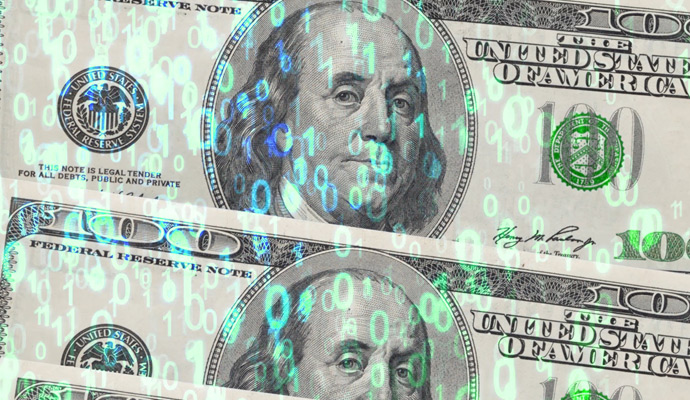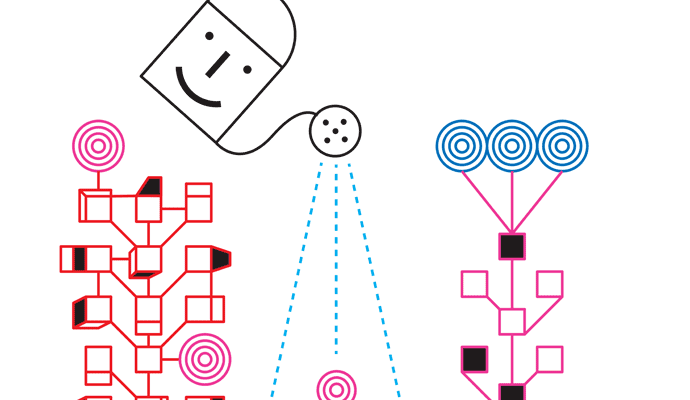How blockchain can improve the aviation industry
Aerospace businesses could benefit from sharing data about aircraft history, maintenance, and operations.
A version of this article appeared in the Autumn 2019 issue of strategy+business.
The aerospace industry is vast (in 2018, revenues were US$838 billion), complex, and interconnected — and growing rapidly. Demand for new commercial aircraft may reach approximately 40,000 planes over the next 20 years. As the companies that manufacture, operate, and service aircraft expand, they are seeking out AI, 3D printing, and other capabilities, technologies, and tools that will allow them to optimize performance. There’s another cutting-edge technology they should consider: blockchain.
What does blockchain, most closely associated in the public mind with cryptocurrencies, have to do with the process of moving 250-ton machines through the air? Simply put, what the aerospace industry doesn’t know about its planes is costing it serious money. Having a more accurate view of a plane’s configuration and maintenance history could help reduce costs and losses, boost asset availability and increase the value of planes in the secondary market and at the end of leases, and improve worker productivity. And blockchain has some unique attributes that will enable it to serve as a powerful tool for the industry. PwC analysis has found that efficiency gains enabled by blockchain could increase industry revenue by as much as 4 percent annually, or $40 billion, while cutting maintenance, repair, and overhaul (MRO) costs by about 5 percent annually, or $3.5 billion. So it’s not surprising that nearly a quarter (24 percent) of aerospace and defense executives who participated in PwC’s 2018 Digital Trust Insights Survey said blockchain was critical to all their lines of business, compared with 20 percent for all respondents across sectors.
Those who embrace the power of a blockchain-enabled ecosystem stand to gain from its unique benefits. First among this group are the operators — airlines and air cargo carriers — who will reap the revenue associated with increased aircraft availability. But other participants in the ecosystem could also benefit, through improved parts traceability — verifying their location and use — or the ability to create innovative revenue models. This opportunity will exist for incumbent manufacturers and maintenance companies, as well as startups working on traceability, outsourcing, and air-traffic control solutions.
Creating a “digital twin”
Depending on its size, a plane can include anywhere from a few hundred thousand parts to several million. But there’s no readily available single snapshot that can show an aircraft’s condition or history. Maintenance companies frequently log records by hand. Those records are often shared in stacks of printed PDFs. Even when data is digitized, it is spread across (and isolated within) multiple parties and systems. Suppliers, vendors, and customers of the same manufacturer, who may also compete against one another, are reluctant to share information. And when there's no provenance or an invoice is missing, a part’s airworthiness must be established through investigation, testing, and recertification — all of which take time and money.
Blockchain’s decentralized, immutable, and consensus-based nature makes it a perfect fit to help overcome these challenges. At the most basic level, every blockchain is a digital ledger of transactions that take place on a peer-to-peer network with the ability to control visibility — who has permission to see which data. Blockchain offers the capacity to create a “digital birth certificate” for every part and update it each time the part moves through the supply chain or is installed on a plane. The part’s status also gets updated every time the plane is serviced or inspected by a technician. That part’s digital record could include the aircraft’s tail number and configuration, the part’s location in the plane, its manufacturer, the identity of each technician who has touched the part, and the location where the service was performed. These digital records can be aggregated into a “digital twin” of the aircraft to provide a real-time snapshot of its condition from the moment it exits the assembly line to the day decades later when it is returned to its lessor or retired from service. And by ensuring that participants have access only to the information they’re entitled to, blockchain could simultaneously improve participants’ visibility into their own businesses while safeguarding their data from competitors.
Potential maintenance use cases for blockchain in aerospace include:
Improving routine efficiency. A continually updated ledger of each part’s condition and usage could help reduce time spent on routine inspection and maintenance by aircraft operators. And that would boost utilization. A blockchain ledger could also streamline heavy maintenance visits, shaving days off a process that often requires significant labor. And combined with predictive analytics, it could allow aircraft operators to shrink spare parts inventories.
Digital records can be aggregated into a ‘digital twin’ of the aircraft to provide a real-time snapshot of its condition from the moment it exits the assembly line to the day 20 years later when it is returned to its lessor or retired from service.
Defeating mercenary parts resellers. When an airline or MRO provider needs to procure an uncommon part, it often turns to vendors in the marketplace. Because there’s no central clearinghouse of aircraft components, it can be difficult to know which vendor has the part they’re searching for. And it’s not unusual to find that many vendors are offering to sell something they don’t yet own. Dealing with resellers in this way adds unnecessary expense in the form of marked-up prices and delays. Participants in a blockchain-powered aerospace ecosystem would be able to compare the serial number of a part being offered against an indelible, real-time record of ownership, location, and utilization. That would allow them to cut out the middle man, reducing the cost of obtaining scarce parts.
Reinventing aircraft maintenance. Today, much maintenance is reactive, conducted only after a problem surfaces or after an issue with a single component has already created knock-on effects. If technicians could review the configuration and history of every aircraft in a fleet on a blockchain ledger, they would be able to engage in more predictive maintenance, and potentially head problems off before they affect operations. The ability to predict the cost of maintaining each individual plane with confidence could also significantly alter the economics of fixed-price MRO contracts. MRO providers that can offer predictive maintenance services stand to gain a competitive advantage over those without access to real-time, blockchain-enabled data. And blockchain could have important safety implications, too. If aviation regulators or manufacturers require supersession of a part, operators could instantly see which planes have affected parts that require inspection or replacement.
Replacing warranties with guarantees. Parts warranties may help aircraft operators control maintenance costs to a degree, but they still require careful inventory management. In the future, blockchain technology could enable the spread of intelligent “power-by-the-hour” service arrangements — in which a supplier guarantees the supply, repair, and overhaul of the components and systems it provides — to every corner of the aircraft. Real-time configuration and maintenance data could allow original equipment manufacturers to predict the condition, usage, and, ultimately, life span of parts or systems and tailor their production processes to make sure spares are available on a just-in-time basis. That would improve service for their customers while cutting their own inventory costs.
Aircraft finance
The wealth of information about a plane’s makeup, usage, and maintenance that could be stored and updated in real time using blockchain technology stands to have a large impact on how aircraft are valued. Finance use cases include:
Building value in the secondary market. Jet engines that are maintained to high standards and that include only verified authentic parts fetch premium prices on the secondary market. With its ability to provide verifiable maintenance records that are updated in real time, blockchain could extend that value to the entire aircraft. If buyers in the secondary market had greater confidence in their purchases and ability to select from the best-maintained planes, the end-of-service value of aircraft could rise.
Transforming leasing. Today, roughly half of the global commercial aircraft fleet of about 23,000 planes is leased. Leasing facilitates growth for airlines and creates balance-sheet flexibility across the industry. But the end-of-lease handoff is often cumbersome, typically requiring the full teardown of the aircraft in order to inventory its parts and assess their condition. However, if the provenance and usage of parts were tracked via a blockchain-enabled solution, only those parts showing high or unusual wear and those required by regulations to be visually inspected might need to be examined more closely. Thus, a higher level of transparency into the condition of leased aircraft could increase residual values.
Workforce
Digitizing credentials. Many of those directly involved in operating or maintaining planes must gain numerous credentials and qualifications. Blockchain technology could make it practical to ensure that the identity of every person who interacts with a plane — and the status of his or her credentials — is recorded and becomes part of the real-time snapshot of its condition. Using a mobile app, workers could verify their identity biometrically (via facial recognition, for example), validate their personal details, and upload proof of credentials. Once validated by the employer and issuing entity, a training certificate or other credential could become part of the worker’s profile on the blockchain. Parties with the appropriate permissions would see in an instant the verified identity and qualifications of the person who installed a part or serviced a plane, providing even greater confidence in the overall snapshot of the aircraft’s health.
Getting started
Building a blockchain solution for aerospace that has the power to deliver the solutions outlined above is no small task. Our experience working with aerospace companies as well as blockchain-enabling solutions — including Air Trace, our proprietary solution built for the industry — leads us to conclude that companies can set themselves on a path toward successful execution by focusing on four key steps early in their blockchain efforts.
Make the business case. Explaining the business value isn’t the same as demonstrating it. Indeed, the risk of overpromising is real. That’s why a successful blockchain data record for the life of an aircraft will necessarily start small — not with an entire airplane, but perhaps with a single system or process. Demonstrated positive results in a workforce credentials use case could help build buy-in for bigger, more ambitious projects. And taking prudent first steps through intelligently sized pilot programs can prevent digital culture shock.
Build an ecosystem. Bringing together stakeholders to agree on standards that will define the business model is perhaps the biggest challenge in blockchain. In some instances, a single, dominant company has enough sway to set standards and rules of its choosing and require others who want to participate to abide by them. This “sponsor-led” model is unlikely to be appropriate for the multipolar aerospace industry, however. Instead, a consortium-based model could prove a better fit. When working together, consortium members establish governance, oversight, and audit mechanisms and to set rules for participation.
Design deliberately. Permissionless blockchains, in which anyone can initiate and view transactions, have many valuable uses. But an aerospace industry–specific blockchain project with the goal of providing data for the life of the aircraft will likely need to have a rigorous array of permissions to ensure that sensitive information is available only to the parties that need it. The governing body, likely an industry consortium, would have the power — and responsibility — to set those ground rules. It’s important to include cybersecurity, compliance, audit, and legal specialists in design decisions from the beginning. Assembling the right team will help avoid costly missteps and build trust among all members of the ecosystem.
Navigate regulatory uncertainty. Although blockchain is a global technology, any solution will have to meet specific jurisdiction requirements. For example, the European Union’s General Data Protection Regulation (GDPR) requires that personally identifiable data be erasable. The regulation is regional, but a global blockchain design has to account for it in workforce-related use cases. We expect similar regulations to influence the design and execution of the proposed use cases outlined above. National aviation and transportation safety regulators will likely also need to be satisfied that blockchain meets their requirements for record-keeping and is at least as reliable and auditable as existing systems. As our Global Blockchain Survey has found, the idea here is to develop solutions alongside simultaneous efforts to reassure regulators — instead of waiting for approval. The goal is to “show, not tell” how transparency works to gain support.
Trust is the most important ingredient in successful blockchain implementations. That may seem ironic for a technology designed to be “trustless,” but bringing together an ecosystem to realize a shared goal with rules all parties can agree to and abide by is no easy feat. Yet it’s essential if blockchain is to deliver on its immense promise.
Author profiles:
- Chuck Marx is a senior advisor and retired partner who led the aerospace and defense practice for PwC US. He has advised Fortune 500 companies for more than 30 years, specializing in the deployment of value-based management and MRO and supply chain systems.
- Rachel Parker Sealy advises clients in the industrial products industry on technology for PwC US, with a particular focus on the applicability of blockchain. Based in St. Louis, she is a principal with PwC US.
- Scott Thompson leads the aerospace and defense practice for PwC US. Based in Washington, D.C., he is a partner with PwC US.
- PwC France partner Matthieu Lemasson and PwC China and Hong Kong partner Andrew Watkins also contributed to this article.





